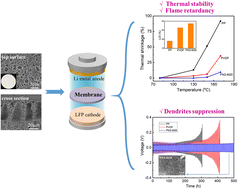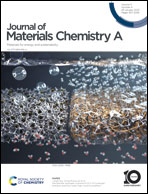A multifunctional composite membrane for high-safety lithium-ion batteries†
Abstract
Thermal runaway and dendrite growth in lithium-ion batteries (LIBs) induce serious safety hazards and impede their further applications. Although extensive advances have been attained in terms of LIBs safety, most studies focus only on a single aspect at a time. In this study, a multifunctional composite membrane fabricated by incorporating poly(vinylidene fluoride) (PVDF) with 2D nickel hydroxide nanosheets (NHNs) and magnesium hydroxide nanosheets (MHNs) was reported for the first time. Compared to the commercial polypropylene (PP) membrane and neat PVDF membrane, the composite membrane exhibits various excellent properties, including higher porosity and electrolyte wettability, and better ionic conductivity and lower interfacial resistance. When used in LIBs, the NHN/MHN/PVDF composite membrane can facilitate uniform lithium deposition at the anode side, realizing effective dendrite suppression. Moreover, it can remain dimensionally stable at temperatures up to 150 °C, preventing LIBs from a fast internal short-circuit at the beginning of a thermal runaway situation. Furthermore, the composite membrane demonstrates greatly improved flame retardancy compared to PP and PVDF membranes. We anticipate that this multifunctional membrane is a promising separator candidate for next-generation LIBs and other energy storage devices to meet safety requirements.

- This article is part of the themed collection: Journal of Materials Chemistry A HOT Papers


 Please wait while we load your content...
Please wait while we load your content...